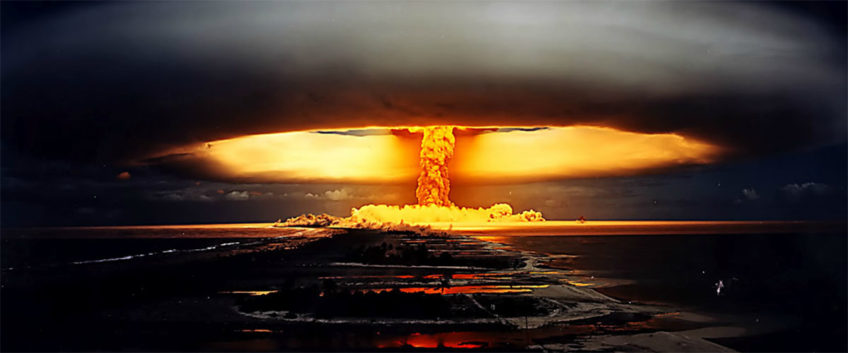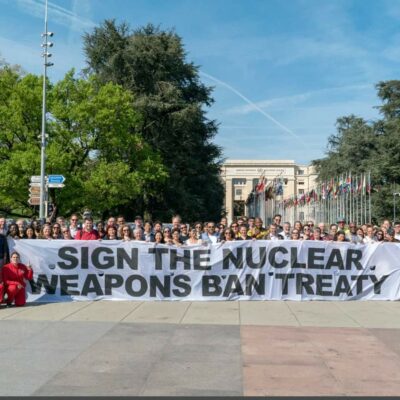Cleveland Peace Action takes these positions on the existence and possible use of thermonuclear weapons by countries possessing such unprecedented destructive power:
1) The U.S. must formally declare a No First Strike policy, stating that the U.S. will not be the first to use nuclear weapons in any conflict, including the Russo-Ukraine war, period.
2) The U.S. must halt nuclear arsenal modernization, with its projected cost of $1.7T ($1,700,000,000,000) over the coming 30 years. The 400 live missile silos scattered in five western states must be closed. Modernizing weapons that are not lawful to be produced or detonated is a waste of money, is unnecessary for deterrence and fuels the global arms race. Making better nuclear weapons puts us in greater danger.
3) The possibility of a misread (accidental or deliberate) of Russia’s statements and actions relative to the ongoing war must be accounted for. Poor communications among the warring parties could quickly cause disaster. The Russo-Ukraine war must be immediately de-escalated and moved to negotiations, with a common expectation of concessions to be made on both sides.
4) Members of the U.S. House and Senate should be encouraged to pass H.R. 2850, which requires the Federal Government to sign and ratify the TPNW. Passage of this law would order the Executive Branch to sign.
5) The U.S. must sign the Treaty on the Prohibition of Nuclear Weapons, joining 122 other nations, none of which have nuclear weapons.
History
Nuclear weapons are the most indiscriminate, destructive, inhumane weapons ever built by humanity. Despite being the ultimate weapons of mass murder and terror, they remain an underappreciated threat to all life on the planet.
If even a tiny fraction of the current global arsenal were launched, an unthinkable level of injury and devastation would occur worldwide. A massive nuclear exchange between the US and Russia would incinerate hundreds of millions of people immediately. But even a “regional” nuclear conflict scenario, where two opposing nations in the subtropics would each use 50 Hiroshima-sized nuclear weapons (about 15 kilotons each, totaling less than 1/10 of 1% of all nuclear firepower on the planet) on major population centers, would result in very substantial human deaths and misery. As much as five million tons of soot would be released into the global atmosphere, which in turn would produce a cooling of several degrees over large areas of North America and Eurasia, including most of the grain-growing regions. The cooling would last for years, and, according to the research, could be “catastrophic”,killing 50,000,000 to 70,000,000 people and disrupting agricultural production and food gathering particularly in countries outside of the tropics. The detonations of 250 Hiroshima-sized bombs would similarly unleash more soot and smoke to darken the planetary atmosphere, causing a planet-wide mini-ice age, associated collapse of the global food system and the deaths of more than 1,000,000,000 people. A U..S.-Russia nuclear exchange would cause a global Nuclear Winter that would within a year or so kill an estimated 8,000,000,000 of the Earth’s people, mostly through starvation. A U.S. nuclear strike against China would result in a similar catastrophe.
Nuclear Arms Control
The United States is one of nine global nuclear weapons-holding powers. The others are the United Kingdom, France, Russia, China, Pakistan, India, Israel and North Korea. Together, they possess an estimated 12,700 nuclear weapons, with the U.S. and Russia holding over 90 percent. As long as these states adhere to maintaining their nuclear arsenals, others are incentivized to develop their own.
The international arms control agreements that for decades provided a level of security against nuclear conflict have been steadily eroded this century. Since 2017,the U.S. has withdrawn from the Joint Comprehensive Plan of Action (aka the “Iran Nuclear Deal”), the Intermediate-Range Nuclear Forces (INF) Treaty, and the Open Skies Treaty. And while President Biden has agreed to extend by another five years the Strategic Arms Reduction Treaty of 2011 (New START) with Russia and has made efforts to rejoin the Iran deal, he has not delivered on his campaign pledges for nuclear disarmament and arms control. Biden has announced the U.S. will not rejoin the Open Skies Treaty of 1992. The Biden administration also is proceeding with the 30-year, trillion-dollar program to “modernize” the U.S. nuclear arsenal that has already led to the development and alarming deployment of the so called “low-yield”, more easily used warheads.
The principal protective treaties remaining in place are the Non-Proliferation Treaty (NPT) and the Treaty on the Prohibition of Nuclear Weapons (TPNW). The NPT came into force 50 years ago, when the U.S., Britain, France, Russia and China led the nations of the world in forming a legally-binding commitment to eliminate all nuclear weapons. In 2000, the United States, together with those same countries, published an “unequivocal undertaking” that they would fulfill this commitment to accomplish the total elimination of their nuclear arsenals. But the US continues to develop and “modernize” its nuclear arsenal, which is a clear statement that it intends to persist in having thermonuclear weapons indefinitely.
The TPNW, also called the Nuclear Weapon Ban Treaty, is the first legally binding international agreement to comprehensively prohibit nuclear weapons with the ultimate goal being their total elimination. It was adopted on July 7, 2017, opened for signature on 20 September 2017, and entered into force on January 22, 2021. It is a binding international law.
For those nations that are party to it, the TPNW prohibits the development, testing, production, stockpiling, stationing, transfer, use and threat of use of nuclear weapons, as well as assistance and encouragement to undertake the prohibited activities. For nuclear armed states joining the TPNW, it provides for a time-bound framework for negotiations leading to the verified and irreversible elimination of its nuclear weapons programme.
Nine nations, including the United States, thus maintain illegal nuclear weapons stocks and manufacturing chains that contribute to a much more dangerous world – one in which every other nation may also decide to claim the same right to develop its own nuclear weapons. Aiding and abetting the perception that each nation may go it alone in determining to have a nuclear weapons program is the appearance of so-called “advanced” nuclear power reactors, also called Small Modular Reactors (SMRs). There are at least ten SMR designs being considered or built. Some designs will rely for their fuel source on reprocessing spent nuclear fuel, which involves separating plutonium and weapons-usable uranium from other radioisotopes to reclaim fuel for nuclear fission. Other SMR types will produce plutonium as a byproduct of fission. Some of the designs will allow refueling while the reactor continues to operate, which makes it possible to conceal the volume and nature of nuclear weapons-usable isotopes and reprocessable nuclear waste generated from producing electricity.
Proponents of the TPNW hope that as more countries sign and ratify it, including key allies of the United States, the U.S. will experience an increase in developing, manufacturing, deploying and justifying its continued dependence on nuclear weapons. Some countries will interpret the “no assistance” clause to mean that U.S. companies engaged in the manufacture and development of nuclear weapons will be prohibited from doing business in those countries. Congress should be persuaded to protect U.S. jobs by promoting conversion to more globally acceptable activities.
The Cost
Nuclear weapons program costs continue to skyrocket: Overall, the Biden administration proposed to spend $50.9 billion on nuclear weapons in Fiscal Year 2023, with $34.4 billion for the Pentagon, which leads in building nuclear delivery systems, and $16.5 billion for the National Nuclear Security Administration, a semi autonomous agency within the Energy Department, that builds and maintains nuclear warheads. These accounts consume 6.5% of the total national defense budget and reflect an 18% increase from the previous fiscal year’s spending. The Pentagon described its request as necessary to implement the 2022 National Defense Strategy, which identifies China as the department’s “pacing challenge” and Russia as an “acute” threat. Russia and China are earnestly upgrading their nuclear weapons systems as a response to the U.S. proxy strategy in waging the Russo-Ukraine war. All this extravagant waste on weapons of mass destruction takes place while money needed to address the climate emergency and its global effects on food and social stability and other pressing needs cannot be found.
In January 2022 for the third year in a row, the experts at the Bulletin of the Atomic Scientists set the iconic Doomsday Clock at 100 seconds to midnight with midnight signifying nuclear armageddon. Since that last reset in January 2022, however, the Russo-Ukraine war began and there are increasing threats of possible nuclear weapons use as that war escalates. Consequently, humanity is probably much closer to nuclear catastrophe than the Atomic Scientists estimate.








Leave a Comment